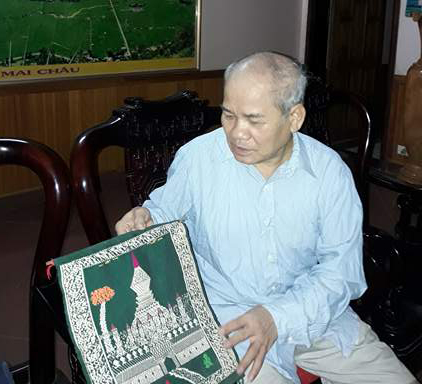
(HBO) – These days, whenever watching TV programmes featuring activities to celebrate the Vietnam-Laos Friendship and Solidarity Year 2017, Ha Van Tuan, former Chairman of the People’s Committee of Mai Chau district, Hoa Binh province, is always filled with sentiments that is difficult to describe with words. Only those who visited the nation of Champa flower can understand these feelings when hearing the names of destinations and people of the country.
Meeting Tuan in a morning in July in Mai Chau town,
Mai Chau district, and listening to his stories, we know that his days in
Laos have
become sacred and priceless memories.

A brocade with That Luang tower embroidery - the
symbol of
Laoshas been preserved by Ha Van Tuan.
In late 1983, Tuan was surprised with delight to be
sent from Mai Chau Agriculture Office to the provincial Committee for
Economic-Cultural Cooperation with
Laos. He was dispatched to Luang
Phrabang to help the province build a pilot agricultural cooperative and
develop high productivity rice varieties. This was part of the economic and
cultural affilication programmes of the two twinned provinces of former Ha Son
Binh province and Luang Phrabang of
Laos.
He was a little nervous when arriving in the country
with strange geographic names, such as the Tay Trang border gate, Nam Bac, Nam
U, and Mekong River, but he became confident with his fluent Thai language. His
team included some leaders of the district, officials of Van Mai commune’s
agricultural cooperative as well as construction and architecture companies.
At that time,
Vietnamwas on a subsidy period with many difficulties, but the living conditions in
Laos were even
more difficult. Locals in the country faced many problems, especially low literacy
and the spreading of malaria, along with poor infrastructure system and tough
roads.
Sharing difficulties facing locals, Tuan and other
members of the working group were resolved to make all-out efforts in order to
help them practically. The first job was to understand local geography as well
as cultivation and production conditions in the locality. Thanks to support of
Lao friends, the working group had many chances to visit hamlets and districts
in Luang Prabang to learn about locals’ farming methods. They, therefore,
proposed using only organic fertilizers, not using or using a small amount of
chemical fertilizers, aiming to generate productivity equal or higher than the
traditional farming methods which used a lot of chemical fertilizers. The proposals
were agreed by their superiors. They helped agricultural officials in Luang
Prabang conduct experiments on rice varieties in order to select suitable
varieties to plant in the locality. With the passion, Tuan rode a bicycle to
the Pak-Suong centre of rice varieties to work together with local agricultural
officials to create new rice varieties. His efforts paid off as productivity
was improved and local agricultural officials and farmers got used to the
advanced farming methods. Tuan collected a lot of memories after the three-year
working trip, from travelling hundreds of km to the experimental centre to
conversations with farmers in Na Sang, Khoi and Pong Van hamlets in Sang Kha
Loc commune to exchange farming experience, or with Lao friends such as Bun
Thin, Hum Phenh, Lot-vi Say, Phu Ma and Kham Keo.
After the re-establishment of Hoa Binh province, Tuan had a chance to
return
Vientianeand Luang Prabang. He was delighted to see changes in UNESCO-recognised Luang
Prabang city and meet with his Lao friends. The city has maintained its
hospitality and lifestyle in the 1980s, which has made it become more beautiful
and memorable. Tuan and other officials of former Ha Son Binh province
contributed to developing the twining relationship between Ha Son Binh and
Luang Prabang provinces as well as between
Vietnamand
Laosin general.
Bui Huy
With just over a month left until the school summer break, students are eagerly anticipating a period of rest and fun after a year of academic pressure. To provide a healthy environment for the physical development, in addition to the classes that foster talents and enhance the academic knowledge, sports and physical activities continue to attract a large number of children and teenagers.
On April 17th, Hoa Binh Provincial Museum organized a program to promote and introduce the outstanding values of "Hoa Binh Culture” at the Boarding Secondary and High School for ethnic minority students in Mai Chau District.
The Hoa Binh College of Technical Technology, in collaboration with the Hoa Binh Technical and Economic College and the provincial Association of Literature and Arts, hosted a gathering on April 15 to celebrate Laos’ traditional Bunpimay (New Year) Festival 2025 and debut the new book "Nguoi Muong o ban Don” (Muong people in Don village).
In the millennia-long history of national construction and safeguarding, people of all ethnic groups in Hoa Binh have been united and closely bound together to overcome all difficulties and challenges, standing alongside the entire Vietnamese people throughout the history of building and defending the country.
Living green is a healthy, positive, and sustainable lifestyle that not only helps protect
the environment and quality of life but also conserves natural resources and ecosystems.
Among the many ways to embrace this lifestyle, reducing plastic consumption is one of the most impactful.
The women's unions at all levels in Kim Boi district have been making significant contributions to the movement of building cultural life in the local community.
The movement helps improve rural look and the spiritual and material lives of local residents.



